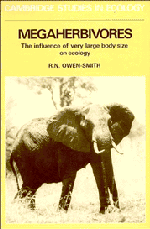Book contents
- Frontmatter
- Contents
- Preface
- 1 Prologue
- 2 Morphology, evolutionary history and recent distribution
- 3 Food and other habitat resources
- 4 Space–time patterns of habitat use
- 5 Body size and nutritional physiology
- 6 Body size and feeding ecology
- 7 Social organization and behavior
- 8 Life history
- 9 Body size and sociobiology
- 10 Body size and reproductive patterns
- 11 Demography
- 12 Community interactions
- 13 Body size and population regulation
- 14 Body size and ecosystem processes
- 15 Late Pleistocene extinctions
- 16 Conservation
- 17 Epilogue: the megaherbivore syndrome
- Appendixes
- References
- Index
6 - Body size and feeding ecology
Published online by Cambridge University Press: 01 June 2011
- Frontmatter
- Contents
- Preface
- 1 Prologue
- 2 Morphology, evolutionary history and recent distribution
- 3 Food and other habitat resources
- 4 Space–time patterns of habitat use
- 5 Body size and nutritional physiology
- 6 Body size and feeding ecology
- 7 Social organization and behavior
- 8 Life history
- 9 Body size and sociobiology
- 10 Body size and reproductive patterns
- 11 Demography
- 12 Community interactions
- 13 Body size and population regulation
- 14 Body size and ecosystem processes
- 15 Late Pleistocene extinctions
- 16 Conservation
- 17 Epilogue: the megaherbivore syndrome
- Appendixes
- References
- Index
Summary
Introduction
It is evident from Chapters 3 and 4 that megaherbivores select high quality green herbage or fruit when these are available, but switch to more fibrous forage during the dry season when choice is restricted. In superficial terms this pattern is not very different from those displayed by smaller ungulates, except for the amount of woody material eaten by elephants at times. Megaherbivores tend to forage for longer over the 24 hour day than do smaller ruminants; but daily foraging times are similar to those of medium-sized non-ruminants like zebras. The home range sizes of megaherbivores are no larger than those of many medium-sized ungulates, again with elephants being a clear exception. To discern body size influences, quantitative data for a range of species of widely varying body size need to be examined.
Diet quality
The nutritional value of food ingested must be adequate to satisfy metabolic demands, otherwise survival chances will be reduced. From the results reported in Chapter 5, total daily metabolic requirements (for maintenance plus activity) are predicted to vary with body size as a function of M0.73. The assimilation rate of nutrients depends both on the capacity of the digestive tract and on the passage rate of its contents. Larger animals can support their lower specific metabolic requirements either by eating less food per day, or by accepting food with lower nutrient concentrations, or some combination of both.
- Type
- Chapter
- Information
- MegaherbivoresThe Influence of Very Large Body Size on Ecology, pp. 82 - 100Publisher: Cambridge University PressPrint publication year: 1988



